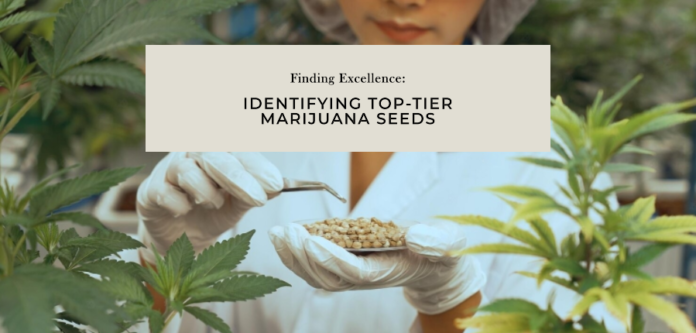In the ever-expanding world of cannabis growing, the significance of identifying high quality marijuana seeds cannot be stressed. Choosing top-notch seeds is the secret to a flourishing and fruitful cannabis garden, whether you’re a seasoned grower or a rookie enthusiast. By selecting premium seeds, you support healthy plant growth and the development of desirable features, potency, and overall output. Investing in top genetics prepares you for a fruitful and successful cannabis farming experience.
This blog will give you thorough instructions to recognize high-quality marijuana seeds reliably. We comprehend how difficult it may be to sort through a wide variety of seed possibilities and determine which seeds have the potential to grow into fantastic cannabis plants and which ones might not. With the help of this blog, we aim to clarify the critical elements that affect seed quality, inform you of accurate techniques for seed identification, and provide insightful information on dependable seed suppliers. You will have the information and tools required by the end of this article to choose marijuana seeds intelligently, advancing you toward a fruitful and successful cultivation enterprise.
Factors Affecting Seed Quality
The quality of marijuana seeds relies on various factors that should be taken into account. To make well-informed decisions and choose seeds with the highest likelihood of success, it’s important to understand these factors. Let’s delve into the key elements that influence seed quality.
Strain selection and genetics
The quality of marijuana seeds is heavily influenced by genetics. Different cannabis strains possess distinct genetic characteristics that contribute to their growth patterns, flavors, aromas, and cannabinoid profiles. Opting for reputable breeders and established seed banks ensures that you work with reliable genetics, increasing your chances of obtaining high-quality seeds.
Seed viability and maturity
Seed maturity plays a crucial role in determining seed quality. Fully mature seeds have a higher probability of germination and successful growth. On the other hand, immature seeds are more likely to be non-viable or produce weak and underdeveloped seedlings. It is crucial to obtain seeds from reputable suppliers who prioritize seed maturity and employ proper harvesting techniques.
The appearance of the seeds
Examining the visual aspects of seeds can provide valuable insights into their quality. While appearance alone is not a definitive indicator, it can offer clues about seed viability. Consider the following characteristics:
Color: Mature cannabis seeds typically display darker shades of brown, black, or gray. Avoid seeds that appear green or light in color, as they are likely immature and have a lower chance of germination.
Size: Although seed size can vary, larger seeds indicate higher maturity and potential vigor. However, remember that size alone is not a foolproof measure of quality, as even small seeds can yield robust plants.
Texture: High-quality seeds generally have a smooth and firm outer shell. Steer clear of seeds with cracked, damaged, or excessively brittle shells, as they may have reduced viability.
Age and storage conditions of the seeds
The age and storage conditions of marijuana seeds significantly affect their quality and viability. Freshly harvested seeds generally have higher germination rates compared to older seeds. Nevertheless, with proper storage conditions, seeds can remain viable for extended periods.
Seed age: Seeds gradually lose viability over time, and their germination rates decline. For optimal results, seeds should be used within one to three years of harvest.
Storage conditions: Proper storage is crucial for maintaining seed quality. Store seeds in a cool, dark, and dry environment to minimize exposure to light, heat, and moisture. Airtight containers and desiccant packs can help protect seeds from moisture and prolong their viability.
By considering the genetics, maturity, appearance, and storage conditions of marijuana seeds, you can increase your chances of selecting high-quality seeds with the potential to thrive.
Identifying High Quality Marijuana Seeds
Securing top-notch marijuana seeds is essential for a prosperous cultivation endeavor. While initially daunting, effective techniques are available to identify seeds with optimal potential for growth and germination. Let’s explore some key strategies for recognizing exceptional marijuana seeds.
Visual Examination
Seed Color and Patterns: Mature cannabis seeds typically display darker shades like brown, black, or gray. Seek seeds with consistent coloring while avoiding those that appear green or light, as they are likely immature or of inferior quality. Some strains may exhibit unique patterns or markings on the seed surface, indicative of specific genetic traits.
Size and Shape Consistency: High-quality seeds often boast a uniform size and shape within a batch. While size alone does not definitively indicate quality, seeds that are excessively small or irregular in shape may possess lower viability.
Seed Shell Integrity: Inspect the seed shell for cracks, dents, or other damage. A healthy seed should possess an intact and undamaged shell, as a compromised shell can impact germination and overall seed quality.
Tactile Assessment
Firmness and Hardness: Gently compress the seed between your fingers to assess its firmness and hardness. High-quality seeds generally exhibit firmness and resistance to pressure. Seeds that feel soft or crumble easily may suggest poor viability.
Texture and Smoothness: Run your fingers over the seed’s surface to check for irregularities or rough textures. High-quality seeds typically feature a smooth and consistent texture.
Float Test
Procedure and Purpose: The float test provides a simple way to determine seed viability. Fill a glass with water and carefully place the seeds in it. Observe whether the seeds sink or float. This test aims to identify viable seeds with a higher probability of successful germination.
Interpreting the Results: Viable seeds generally sink to the bottom of the glass, while non-viable or low-quality seeds tend to float or remain suspended in the water. It’s important to note that the float test could be better, but it can offer a rough indication of seed viability.
Germination Test
Steps to Perform a Germination Test: A germination test involves attempting to germinate a few seeds before committing to a larger batch. Here’s a simple method for conducting a germination test:
Dampen a paper towel or cotton pad with water, ensuring it is moist but not excessively wet.
Place a few seeds on the moistened paper towel.
Fold the paper towel over the seeds to cover them.
Keep the paper towel in a warm, dark location, such as inside a sealed plastic bag.
Regularly check the seeds for germination, typically within a few days to a week.
Evaluating Germination Rate: Once the germination period has concluded, tally the number of successfully sprouted seeds. A higher germination rate indicates superior seed quality.
By employing methods such as visual examination, tactile assessment, conducting a float test, and performing a germination test, you can obtain valuable insights into the quality and viability of marijuana seeds. When utilized collectively, these techniques offer a comprehensive approach to identifying high-quality seeds more likely to yield healthy and thriving cannabis plants.












